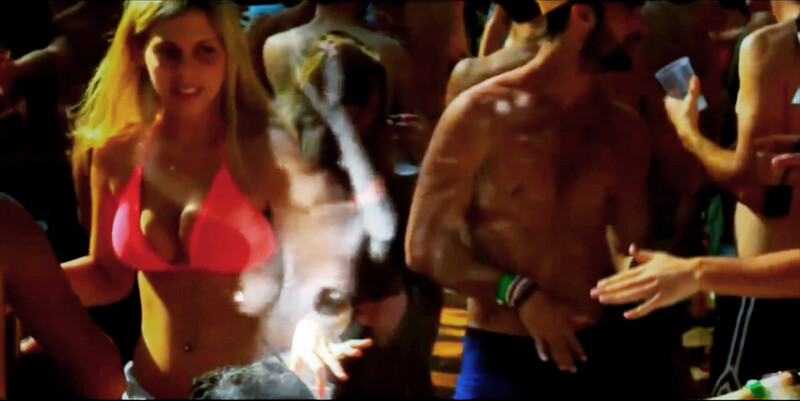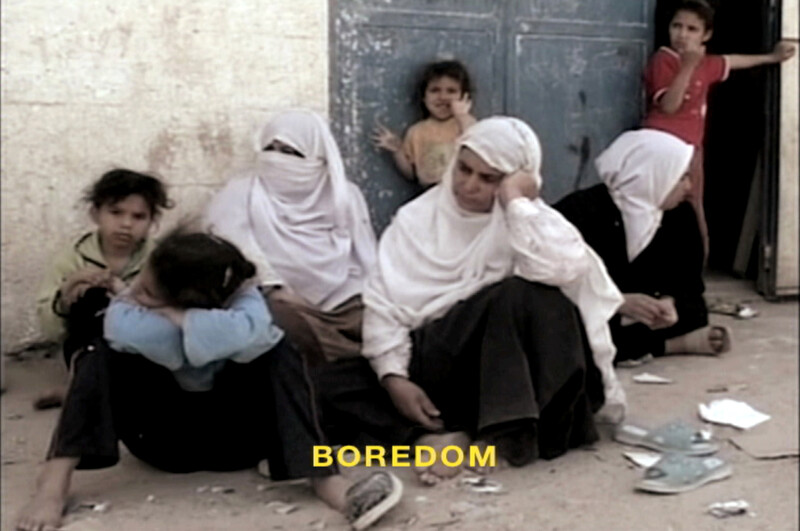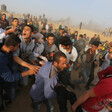The Electronic Intifada 20 July 2017

Production still from Ouroboros
Palestinian artist Basma Alsharif’s experimental first feature film takes up the end of civilization, with Gaza as the theme’s launching point.
The film, titled Ouroboros, was born out of her experience in Gaza during Israel’s November 2012 military offensive.
“I was in total shock, because war seems so sensational when it’s reported … and when you’re actually in it, it’s like, ‘Oh, wow, this is random and senseless,’” Alsharif, who was born in Kuwait and grew up in France and the United States, told The Electronic Intifada.
“You realize life just has no value to the people bombing. I was thinking, especially when they would bomb empty sites over and over just to scare the people, yeah, this is really the end of humanity, and of civilization.”
Yet, for Alsharif, hopelessness is not a foregone conclusion, and she seeks instead to put forth new concepts of futurity and renewal in the wake of destruction.
“Ouroboros, the tail-biting snake that appears in Greek mythology, is a process of renewal,” Alsharif stated at an April screening of the film during the Whitney Biennial in New York City.
The allegorical Ouroboros is sensorially immersive, featuring lush imagery, dynamic sound design and dreamlike sequences.
The film is also challenging, replete with historical and literary references but presented in a fragmented narrative.
Drone’s eye view of Gaza
Ouroboros begins and ends with Gaza. Alsharif opens her film with a two-minute-long aerial drone shot of the coast. The footage is played in reverse, showing the waves receding away from its shoreline.
The drone surveys the destruction in Gaza after Israel’s catastrophic assault during the summer of 2014. The imagery is visually arresting, yet cold and robotic.
“The drone vision … is a surveillance strategy, to make us aware that we’re looking at a place that we can’t access, that we are surveilling them,” Alsharif explained.
In a stunning shot, an anonymous Palestinian man stands and waves atop a tall, badly damaged concrete building as the drone passes over him. The moment demands consideration of what came before and what will follow this destruction, positing the film’s central question: how can Gaza proceed through its trauma, when its tragedy seems doomed to repeat?
The film strings together narrative vignettes in which a young male protagonist, unnamed in the film and performed by Alsharif’s friend Diego Marcon, wanders in and out of geographically disparate spaces: Native American territories in the Mojave Desert, the ancient Italian city of Matera, a castle in Brittany and a small home in Los Angeles.
In one open landscape, the young man walks silently as a narrator states, “Perhaps out of vanity, it seems to me inappropriate that the place where I was condemned to live should not appear shut in, but spread out and almost welcoming.”
Gaza’s confinement
The man’s nomadism throughout a constantly shifting global and cinematic landscape is in contradistinction to Gaza’s confinement, blockaded by both Israel and Egypt.
Alsharif explained that the sites were intended to highlight Gaza through contrast.
“The stone in this 13th century castle [in Brittany] that is so preserved and pristine is such a good counterpoint to the ruin of Gaza,” she said during her presentation at the Whitney Museum of American Art in New York City. “The Mojave and LA have their own significance. The Mojave looks like we’re doomed, it’s dried up. We’re filming on a dried lake bed.”
In Ouroboros, the unnamed young man meanders in and out of architectural spaces and partakes in mundane actions, often playful and sometimes somber. His actions in the film are frequently played in reverse: smoke recedes into a cigarette, olive oil retreats from a plate and back into a bottle. The motif of reverse motion, dreamlike in quality, mimics the fluid concept of the Ouroboros.
In one scene, the main character enters a library in the Mojave desert with an anonymous woman, who reads aloud an excerpt from Heart of Darkness, Joseph Conrad’s 1899 novella about a European man’s colonialist voyage up the Congo River. The protagonist interrupts her with a card trick that eventually fails, and she continues to read.
The episode references multiple episodes of violence and erasure, calling into question who is writing and speaking about their histories.
Throughout the young man’s journey, sounds and thematic motifs repeat and reference each other. The settings in which he appears, including domestic spaces and a lush garden, often refer to an early sustained steadicam shot that journeys through Alsharif’s large family home and garden in Gaza. The camera follows the estate’s caretaker as she walks past family portraits, bookshelves holding John Grisham novels and Gaza YMCA trophies, and through a sun-filled garden of fruit trees.
The main character’s journey is not resolved, but is cyclical, signaling that the film is less about his quest than his present situation in each place, and how it may connect to Gaza’s present context, history and future.
“Ouroboros for me was linked to the idea of the eternal return, and that the only way we can move forward is to forget,” Alsharif said. “If we don’t do that, then we’re also doomed to repeat our mistakes and to destroy ourselves.”
“Post-Palestinian” artist
Much of Alsharif’s work posits that history and national identity are withholding forces, leading her to be described as a “Post-Palestinian” artist, a label she has adopted. “I’ve maybe accepted that we’re not going to be liberated in the way we think we’d like to be – how can we imagine the future then?” she told The Electronic Intifada.
Alsharif recognizes that this perspective is controversial, and rooted in her position in the diaspora: “It was at the privilege of distance that I was able to reflect on the future of the conflict.”
She insists on Palestinians’ human rights, but is critical of nationalist aspirations.
“We have governments that are not representing what we want, neither Hamas or Fatah, and the future is just coming straight at us and we seem to be unprepared,” she said.
“I know something has to be done when we’ve been waiting for decades to be citizens. But I think we will always be stuck in the past if we don’t realize that Israel is not going anywhere, it’s a modern state and we have to deal with this beast; we have to accept that we’ve lost to a certain degree.”

Production still from O, Persecuted
The Palestinian national movement’s utopian vision is contrasted by current reality in Alsharif’s 2014 work O, Persecuted.
The short film takes up the restoration of Our Small Houses, a 1974 propaganda film by Kassem Hawal, who produced work for the leftist Popular Front for the Liberation of Palestine. Hawal’s film is glimpsed only in bits, obscured by an aggressive soundtrack that mimics the sounds of war.
Alsharif is shown, in grainy black and white, spreading black paint over a projection of Our Small Houses. But the action is played in reverse, giving the impression that the film is being uncovered. This slow performance is followed by an explosive montage of Israeli nightclub commercials, featuring bikini-clad partyers and electronic music. The uncovering of the archival film reveals the present reality.
“Sometimes I think these things should still be buried,” Alsharif told The Electronic Intifada. “There’s this huge effort to restore these films, but a lot of those films are propaganda and for me, the way they speak is problematic. I wanted it to seem like I’m taking a corpse out of the ground, we’re digging up this thing that says, ‘Look, we were so great!’ But we weren’t … if we were, we’d be free.”
“Numbers stop being numbers”
Alsharif’s work questions common symbols of Palestine and the identities and ideologies that they invoke.
Alsharif’s experimental 2009 short film, We Began by Measuring Distance, narrated by a disembodied male voice in Arabic with English subtitles, juxtaposes the playful with the melancholy. The narrator describes a group of friends beset by boredom, calling it “the worst of all evils,” as the viewer sees an image of Palestinian women and children sitting on the curb of a street, looking forlorn, perhaps referencing the banality of life under siege in Gaza.
Boredom leads the group into a game of measurements, calculating the degrees of a circle and the lengths of small objects. Their measurements become increasingly political as they calculate global distances. The group finds the distance between Gaza and Jerusalem to be 78 kilometers, but recalculates their answer to be 67, 48 and 17, numbers representing landmark years in the history of the Zionist colonization and occupation of Palestine.
“The work is about how, as a Palestinian, you’re handed this information about the conflict,” Alsharif said. “Numbers stop being numbers, 67 is never just 67… 48 is always the Nakba and 17 is always Balfour, and sometimes these numbers stop having meaning … they just become images or things that we can’t separate emotion from.”

Production still from We Began by Measuring Distance
The group’s game of measurements doesn’t reveal any answers, and the film eventually returns to Gaza’s tragedy, juxtaposing the horrific images of phosphorous bombs breaking over Gaza with pleasurable scenes of swimming jellyfish and carnivalesque music. The juxtaposition creates a spectacle of Gaza’s tragedy, calling into question how it is typically represented and viewed in popular media.
Alsharif added: “I wanted to make work that was clearly about how things are represented. It doesn’t matter if we know all the facts, all the injustices, and have images … this isn’t what will change policy or end injustice or change where power lies.”
While Measuring Distance features an Arabic narrator, Ouroboros is narrated in Chinook, a North American indigenous language, with English subtitles. The film’s many pluralities – in spaces, languages and histories – signal Alsharif’s global vantage point.
Ouroboros culminates with the protagonist dancing to a bass-driven song in front of an open landscape, as the many sceneries of Ouroboros are intercut to the music’s fast tempo.
The energetic sequence formally sums up the film’s conceptual argument, in which Gaza is not distinct from other global histories and spaces, but rather is in flux with the world. The protagonist’s dance, fleetingly glimpsed between pulsating shots of rubble in Gaza, lush forests and open landscapes, feels celebratory.
A rejection of the isolation imposed on Gaza and the stasis that those who maintain it hope to engender, the visceral conclusion emphasizes that despite its somber pretenses, Ouroboros is ultimately about hope.
Editors’ note: an earlier version of this article misspelled the name of the actor who plays the protagonist in Ouroboros. It has since been corrected.
All images courtesy of Basma Alsharif.
Daryl Meador is a filmmaker and academic from Texas currently pursuing a PhD in cinema Studies at NYU. Twitter: @darylmeador.





